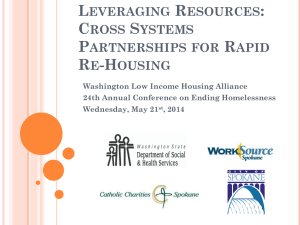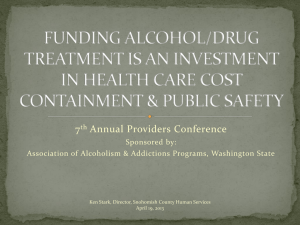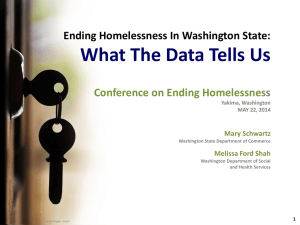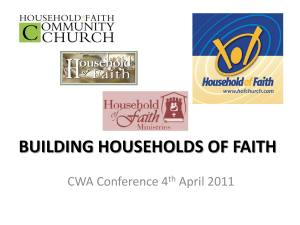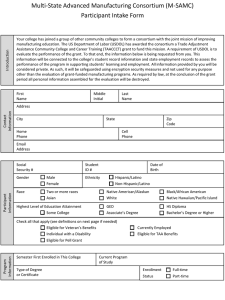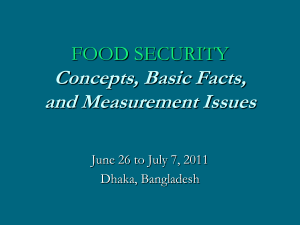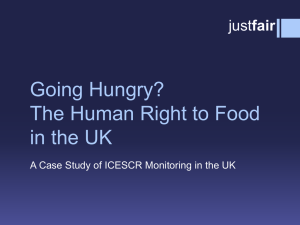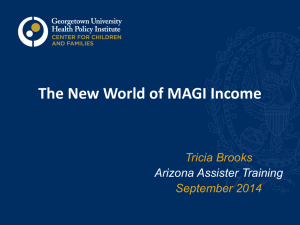Basic Food Eligibility PPT
advertisement
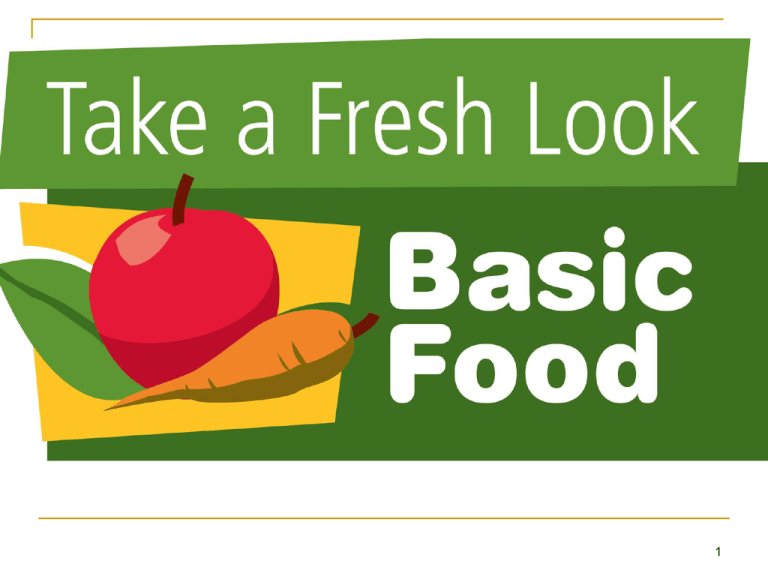
1 Basic Food Program is a food & nutrition program for individuals & families who meet income guidelines. Formerly, known as the food stamp program. Basic Food helps people to afford a nutritious diet by providing eligible households an electronic benefits card & monthly benefits to buy food at participating grocery stores. Income limits are 200% of the federal poverty level! Net income limits & asset limits are waived for most clients! Please note we are only contractors for DSHS. We are not DSHS employees. Our goal is to help you understand the rules and eligibility in order to help clients in Washington State receive Basic Food Benefits. 2 Basic Food Program name In Washington State the food program is called “Basic Food Program”. However, the federal name for the Basic Food Program is called Supplemental Nutrition Assistance Program (SNAP). www.fns.usda.gov/fsp/snap.htm 3 Basic Food Eligibility Individuals who reside in Washington State must meet the following: Be a Washington State Resident Citizen requirements (U.S. citizens & lawfully admitted resident who meet the 5 year residency requirement & some non-citizens. Individuals who are lawfully admitted but have been here for less than 5 years, may be eligible for the State Funded Basic Food Assistance Program (FAP) Must meet income requirements—before taxes & deductions Give DSHS their social security number Resource are not counted for most individuals (I.e. value of vehicle, bank accounts) Agree to participate in the Food Assistance work & training program. (if applicable) 4 Who is eligible for State-Funded Basic Food Assistance Program (FAP)? A Washington resident who does not qualify for the federal Basic food program due to citizenship status may be eligible for the state-funded basic food program. It consist of two groups: Qualified aliens who have not met the requirements for age, work quarters, or 5year timeframe as a qualified alien in order to be eligible for the federal Basic Food program. Nonqualified aliens who are immigrants, but will not be eligible for federal benefits unless they have an adjustment of their immigration status. These immigrants are referred to as Persons Residing Under Color of Law (PRUCOL). Persons considered PRUCOL are legally in the U.S., but do not have an official status as a qualified alien with the U.S. Citizenship and Immigration Services. Immigrants, such as applicants for political asylum or withholding of deportation, who have not yet received a final order are considered PRUCOL. 5 What about individuals who are undocumented? If individuals are undocumented they are not eligible to get benefits for themselves……….HOWEVER, if they have US Citizen Children or children with legal documentation & social security number they can apply for them. Although the entire household is listed on the application, only the US Citizen child will get benefits. DSHS is not required to turn over Basic Food applications/information over to INS. 6 Basic Food Eligibility Basic Food Eligibility is always based on the household size…… If persons are sharing a residence & they: Buy food together; Prepare meals together; or Buy food and prepare meals together They are considered part of the household size & their income will be included to determine eligibility. If the client applying has a biological, adoptive or step child living with them under the age of 22, they are always considered part of the household size….even if they don’t share the food. 7 What if my homeless friend lives with me—can they apply since we share food? (YES) When someone shares your home (except children under age 22) DSHS will ALWAYS want to know if they: Buy food together; Prepare meals together; or Buy food and prepare meals together. If the person applying does not currently buy and prepare food separately from others in the home only because they have no food or money to buy food, they can apply and only their income will count. 8 Buy Share Food—DSHS rules WAC 388-408-0035 Buying and Preparing food: This rule (formerly known as the “purchase and prepare concept”) applies to the typical shopping and food preparation arrangements of the people who live in the home. Persons who normally buy and prepare their food separately can be in separate AUs if they do not have to be in the same AU for some other reason. This rule does not force people to be in the same AU if they occasionally share a meal or share insignificant items such as seasonings. It also doesn’t force people to be in the same AU if they buy food and make meals separately, but eat their meals together. Buying and Preparing food – Temporary arrangements based on no food money: If a client does not currently buy and prepare food separately from others in the home only because they have no food or money to buy food, they may be a separate AU from the others in the home if they are not required to be in the same AU under WAC 388-408-0035 (2) and they intend to buy and prepare food separately from the others. Shared Living Arrangement Form #DSHS-14-393 http://www.dshs.wa.gov/forms/eforms.shtml 9 Example #1 Kari & Steve are unmarried & share an apartment. They combine their money to buy groceries for shopping but don’t normally prepare meals together because they work opposite shifts. --Since they buy food together they would be in the same Assistant Unit and both of their income will be used to determine eligibility. 10 Example #2 Kari & Steve share an apartment. Kari prefers a vegan diet & Steve doesn’t. Because of their diets they normally do not buy or prepare food together. They do share salt, pepper & spices. Since Kari & Steve do not normally buy & prepare food together, they are separate Assistant Units and their eligibility is determined separately. 11 Can you be a student & get Basic Food? Yes. DSHS considers someone a student if they are: 18-49 Physically & mentally able to work & Enrolled in an institution of higher education at least half-time as defined by the institution How does DSHS define as a institution of higher education? It’s an institution that requires a high school diploma or GED; A business, trade or vocation school that requires a high school diploma or GED A two-year or four-year college or university that offers a degree but does not require a high school diploma or GED. 12 Student Status continues……. Students must also meet one the following: Have paid employment of at least 20 hours per week. Self-employed, work at least 20 hours per week & earn at least the amount of federal minimum wage ($7.25 per hour) Participate in state or federal work study at time they apply for Basic Food. Responsible for more than half the care of a dependent person in their household five or younger. Responsible for more than half the care of a dependent person in their household six & eleven if DSHS determines there is not adequate child care available. 13 Example #3 Karen attends a technical college that offers both a two-year degree program & a one-year certificated program. The degree program requires a high school diploma or GED for enrollment, while the certificate program has no such requirements. Karen enrolled in the one year certificate program curriculum. Is that higher education? No! A certificate-only program does not require a diploma or GED. Karen is not considered to be enrolled in an institution of higher education. Karen is not considered a student for Basic Food. 14 What about students living with their parents? Any child (student or not) under the age of 22 living at home with their parents can apply. However, their parents income will count towards eligibility. And meet one of the following: If they are students over the age of 22, they must have at least a part time job or are self-employed-----minimum 20 hours per week or enrolled in federal or state work-study program. Responsible for more than half the care of a dependent person in their household five or younger. Responsible for more than half the care of a dependent person in their household six & eleven if DSHS determines there is not adequate child care available. And they must buy, cook & prepare their food separately. 15 Example #WAC 388-408-0035 Rule: Adults living at the same address as their parents: If a person age 18 through 21 lives at the same address as their parents, this person can be a separate AU from the parents only if they have separate living, cooking, and sanitation facilities. EXAMPLE An 18-year-old woman lives in a basement apartment at her parent’s residence. The apartment has a small kitchen, living room, and bathroom that only the 18year-old uses. If this person usually buys and cooks her food separately from her parents, she can be a separate AU. EXAMPLE Applicant age 21 lives in a camper in the parent’s yard. The camper does not have a bathroom (only a porta-potty) so the applicant uses the bathroom in the parent’s residence for showers. This person is not a separate AU. 16 Can single individuals (people without children) apply for Basic Food? Able-bodied adults without dependents (ABAWDs) are age 18-49 and have no dependents. They must, unless determined exempt, participate in specific employment and training activities to receive food assistance. Nonexempt ABAWDs who fail to participate may continue to receive food assistance until September 30, 2013. Beginning October 1, 2013, an ABAWD is not eligible to receive food assistance for more than three full months in a thirty-six month period unless that person: Works at least twenty hours a week averaged monthly; or Participates in and complies with the requirements of a work program for twenty hours or more per week; or Participates in a workfare program 17 There are some individuals who are exempt from these changes--example: Under 18 or individuals over 50 Determined to be physical or mentally unable to work A member of a household with the responsibility of a person determined to be incapacitated Pregnant Student Participation in a chemical dependency program Working a minimum of 30 hours per week Receiving unemployment benefits (WAC 388-444-0035 has more exemptions) 18 How is income calculated? DSHS must count actual income in the month of application. This includes all include in the household unless that income is excluded (WAC 388-450-0162). DSHS uses a clients present, past & future income to determine eligibility. They use two methods to estimate income: Anticipating monthly income (AM): They use this method, to estimate the actual income the client expects to earn. Averaging income (CA): With this method, they add the total income a client expects to receive for a period of time & divide by the number of months in the period. DSHS determines a monthly amount of their income based on how often you are paid: If they are paid weekly, they multiply the expected income by 4.3; If they are paid every other week, they multiply their expected income by 2.15. 19 What if a client is self-employed? They need to provide proof of their income & business receipts. If client does not provide any receipts (only income) DSHS will only deduct $100.00 from their self employment income. DSHS will also accept the most recent tax return. The client must include the entire tax return including all schedules (.i.e. schedule c, f) They will add together their gross selfemployment income and any profit they make from selling your business property or equipment; They will subtract the business expenses and Divide the remaining amount of self-employment income by the number of months over which the income will be averaged. DSHS does not accept the following deductions on the self-employment worksheet: a. Federal, state, and local income taxes; b. Money set aside for retirement purposes; c. Personal work-related expenses (such as travel to and from work); d. Net losses from previous periods; e. Depreciation; or f. Any amount that is more than the payment you get from a boarder for lodging and meals. 20 Self employment continues…… What if a client did not file a tax return? DSHS will add together their gross self-employment income & profits from selling a business property or equipment over the period of time the business has been in operation within the last year Subtracting their allowable business expenses Average the income they estimate a client will get for the coming year Client must have proof of income & receipts! Self Employment Worksheet DSHS 07-042B 21 What if a client has a corporation? Self-employment is complicated. And when a client has an LLC or Corporation that’s even more problematic! When a client is incorporated that means they are NOT self-employed. They will normally write themselves a check each month. DSHS needs the complete tax return including schedule “k” along with proof of their income from the corporation. And year end dividends paid out at the end of the year. 22 Example Self-employed client applies for Basic Food on April 14. Worker determines income from self-employment is primary source of household income and calculates average monthly income verified from most current federal tax return which shows gross income from Schedule C for previous year, after deductions allowed under WAC 388-450-0085, as $16,500. Worker divides this amount by 12 to get average monthly income of $1,375. This amount is used to calculate benefits for month of application and ongoing months. Benefits for application month are prorated to include April 14-30. 23 What if a client is paid in cash? DSHS still needs to verify their income! Employer statement by telephone or in writing Bank statement that shows direct deposits (many deposits show the net amount, client may need to show gross income) Collateral statement Statement of collateral Information DSHS 14-222 24 How much does a client receive in benefits? Are there deductions? Monthly benefits will vary depending on the number of people in the household, income & living expenses. Family Size Standard Deductions 1-3 $149.00 4 $160.00 5 $187.00 6 or more $214.00 Actual cost of dependent child care expense for clients who are: Working Looking for Work Attending training or education to prepare for employment 25 More information on deductions & benefits………... It’s the income after your deduction that determines your monthly benefit amount. 20% deduction for earned income Medical expenses over $35.00 (clients who elderly or disabled Legally obligated child support Shelter Cost (Up to $469.00 if no one in the household is elderly or disabled) DSHS won’t request proof unless it’s questionable. Household Size Maximum Benefits 1 $200.00 2 $367.00 3 $526.00 4 $668.00 5 $793.00 Let’s practice!! 26 How long does eligibility last? DSHS now certifies almost all households for 1year. Homeless and ABAWDS are now certified for 1 year instead of just 6 months. The only households that are not certified for 1 year are WASHCAP clients (this is a project with SSA for certain SSI clients and is mostly automatic) and those on transitional food assistance. 27 What documentation do you need in order to get approved? Provide social security number (person applying for benefits) Proof of identity (head of household) Please note if client does not have proof of identity, DSHS can verify identity through their various computer systems. If a person is completing an interview by phone, they don’t have to bring us ID before we can issue their benefits as we can identify them in other ways. Proof of income (Remember eligibility for Basic Food is based on household size) Proof of living expense 28 Additional benefits when you’re receiving Basic Food! Recipients also automatically qualify for the Washington Telephone Assistance Program (WTAP) or Free Cell Phone with 250 minutes Automatically enrolls school-age children in the free school meal program Shows that your family meets the Women Infants & Children (WIC) income test. 29 Some people who are income eligible will get “Zero” benefits……. According to Federal Law, after a client pays rent, utility, child care expense, 30% of their net income that is left needs to pay for food. Therefore, if the 30% that is left over is more then the maximum amount of Basic Food benefits for that family size, they are considered income eligible for Basic Food with -0- benefit amount. 30 Some people who are income eligible will get “Zero” benefits……. Family size is 1 or 2 & they meet income guidelines, they will automatically default to $16.00 for US Citizens and $8.00 for clients eligible for state funded Basic Food. Remember…….even if the client is income eligible but they gets “zero” benefits they are still eligible for: Telephone Assistance Program Free lunch program for their children Meet the income test for WIC 31 Does client need a face-face interview? What happens if they miss their appointment? Interviews In most cases clients can do an interview over the phone or they can go into a local CSO between 8:00-2:00 each day for an in-person interview. You can apply and receive benefits the same day even if the case is not considered expedited. Applications that are completed on line or mailed need to show up in their ACES computer system before the client can have an interview. Effective date of approval Once approved coverage will start on the date the application was received. What if the client misses their appointment? If a client fails to keep or reschedule their interview in the first 30 calendar days after their application is received their application will be denied on the 30th day. If the client is still interested in Basic Food benefits, they will need to reapply. Benefits will be based on your second application date. 32 What happens if I need Basic Food immediately? The client may be eligible for expedited benefits. Which means they could get benefits within 5 calendar days. The client must provide proof of who you they are and meet one of the following conditions: Have gross monthly income, before taxes, under one hundred fifty dollars and have available cash one hundred dollars or less; or Have gross monthly income, before taxes, plus available cash of less than your total shelter costs (rent or mortgage and the utility allowance Be a destitute migrant or seasonal farm worker household and your household's available cash is one hundred dollars or less. 33 Expedited Food Assistance Continues….. If client is eligible for expedited service & not required to have an office interview they can have a telephone interview and still get benefits within five days. Client will be required to prove their identity in order to get benefits within five days. Other required verifications may be postponed. In order to get continued benefits clients will need to provide additional documentation. If the client applied before the 15th of the month, DSHS will issue one month’s benefits and the client has thirty days from the date of application to give us any postponed verification; or If they applied after the 16th of the month, DSHS will issue two months’ benefits & the client will have until the end of the second month to give us any postponed verification. 34 What happens if I’m denied? WAC 388-406-0065 For cash or medical assistance, they have 30 days to submit the requested documents to DSHS. For Basic Food, they have sixty days from the date they applied for benefits. 35 How does a client get an EBT card? If a person already has an EBT card from a previous time, that card is still good and they won’t need another one. If they are new to receiving benefits or they no longer have their old card, they may want to go to the local CSO to pick up their initial card as having it mailed to them could take up to 10 days. When a client loses their card it can take up to 10 days to replace. It’s quicker to call JP Morgan directly for a new card 1-888-328-9271. If a client is homeless (known as homeless by DSHS) they can get their cards at the CSO. If DSHS suspects fraud, it can take longer for a client to receive a card. 36 Problems? 1. Make sure you have a signed DSHS consent. 2. Review the rules in DSHS EAZ Manual http://www.dshs.wa.gov/manuals/eaz/sections/PS_FedFoodAssist.shtml Call the Statewide Call Center for assistance 1-877501-2233. If the issue is still not resolved ask for a lead worker. If you’re still not having any success remember the client has the right to request a fair hearing! 37 Contact Information…… Thank you to Truong Hoang, Financial CoordinatorPublic Relations Manager (DSHS) & Linda Yokes Medical Financial Coordinator (DSHS) for their collaboration in reviewing the slides. Liz Snow -Community Outreach Coordinator (206)830-7655, & Anna Zimmerman -Outreach and Marketing Coordinator (206) 830-7652 WithinReach (withinreachwa.org) or 1-888-436-6392. Daphne Pie -Program Manager, Public Health-Seattle & King County (kingcounty.gov/health/access) (206) 263-8369 or 1-800-756-5437 Thank you all for attending!!! 38

